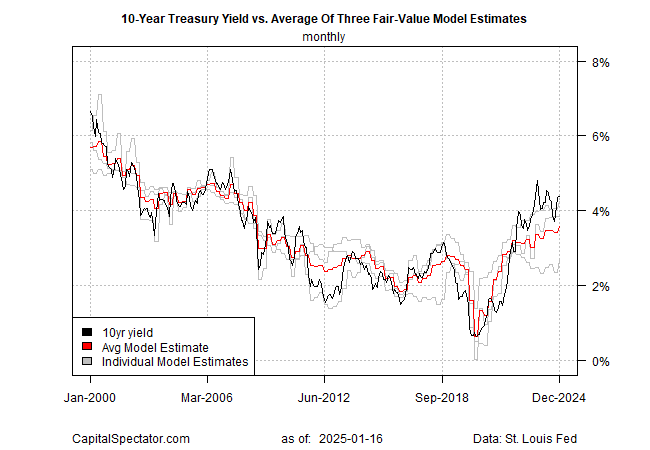The market premium for the US 10-year Treasury yield eased in December after rising for two straight months. The analysis uses a “fair value” estimate calculated by CapitalSpectator.com. Despite the downshift, the market continues to price the 10-year yield at a relatively high level compared with the pre-pandemic range.
The current market premium over the average fair value (based on the average of three models) fell to 81 basis points last month, which is slightly above the average premium for past year.

The elevated market premium over the average fair-value estimate coincides with recent concerns about “sticky” inflation and uncertainty about how policy changes planned by the incoming Trump administration will affect pricing pressure in 2025.
Yesterday’s December report on US consumer inflation presented mixed results. The year-over-year change in the consumer index sped up, rising 2.9% in the final month of 2024 vs. the year-ago level. The faster pace marks the third straight month that the consumer price index at the headline level picked up. The current rate is the highest since July. The core rate of CPI, by contrast, ticked lower to 3.2%, which is holding within a tight 3%-plus range that’s prevailed recently.
“When you step back and look at the overall state of inflation, we’re not really going anywhere,” says Sarah House, senior economist at Wells Fargo. “While there has been progress, the pace has been really disappointing.”
The market premium for the 10-year yield shot higher in 2022, when pandemic-related inflation surged. As inflation has downshifted, the market premium has declined, as shown in the chart below. But the current premium remains above the pre-pandemic heights, which suggests that investors remain anxious about the inflation outlook.

The main uncertainty is how or if the incoming Trump administration’s policy changes will alter expectations. It’s likely that until there’s more confidence that inflation will move closer to the Fed’s 2% target, the market will demand a relatively high yield premium over the estimated fair value for the benchmark rate.
